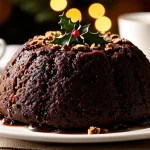Ingredients and Equipment Needed for Classic Sticky Toffee Pudding
Choosing the right sticky toffee pudding ingredients is crucial for crafting an authentic dessert. The traditional sticky toffee pudding relies on a few simple yet specific components: ripe dates, which provide moistness and sweetness; dark brown sugar or muscovado for a rich, caramel-like flavor; self-raising flour to give the pudding its soft, tender crumb; and butter, eggs, and milk to bind the mixture and add richness. Incorporating vanilla extract or a pinch of baking soda can enhance the texture and depth of flavor. Using high-quality, fresh ingredients guarantees a superior result.
When it comes to home baking essentials for this dessert, certain tools are indispensable. A mixing bowl and a sturdy spoon or electric mixer facilitate thorough blending of the sticky toffee pudding ingredients. A heatproof baking dish or individual ramekins work well to hold the batter during baking, and an oven thermometer ensures consistent temperature control. Additionally, a fine sieve may be helpful if you want to ensure a smooth batter without lumps, while a small saucepan is necessary later for the toffee sauce preparation.
In the same genre : What tips can enhance your homemade fish and chips experience?
For those with dietary needs or preferences, there are straightforward ways to adapt the recipe without compromising taste. Substituting gluten-free flour blends allows for a gluten-free version, while coconut sugar or maple syrup can replace traditional sugars for a different sweetness profile. Plant-based butter and milk alternatives also suit vegans wanting to enjoy this classic dessert. These variations and substitutions maintain the integrity of the pudding while broadening its reach to varied diets.
Selecting the correct ingredients and assembling the proper tools sets the foundation for achieving the beloved moist texture and rich flavor synonymous with the traditional sticky toffee pudding. Careful attention here makes all the difference in baking success.
In parallel : What are the key flavors in a traditional British Christmas pudding?
Preparing the Pudding Batter
Crafting the perfect sticky toffee pudding batter begins with carefully combining the key ingredients. Start by softening the dates—ideally, use finely chopped, pitted dates soaked in warm tea or boiling water for at least 10 minutes. This technique enriches moisture content and tenderness, which are essential for the traditional sticky toffee pudding texture. Drain the dates but reserve the soaking liquid to incorporate back into the batter, preserving flavor and consistency.
Next, cream the butter and dark brown sugar until light and fluffy, ensuring the sugar dissolves well for a smooth batter. When eggs are added, incorporate them gradually, mixing thoroughly to avoid curdling. Sift the self-raising flour with a pinch of baking soda to maintain the pudding’s lift and softness. Fold the flour gently into the wet mixture, then stir in the softened dates along with some of their soaking liquid to keep the batter moist.
When preparing sticky toffee pudding, attention to ingredient quality is crucial. Using fresh, high-quality dates will impact both sweetness and texture. Eggs should be at room temperature to blend seamlessly, and butter should be unsalted to control seasoning precisely. Avoid overmixing once flour is added to prevent a dense pudding.
For best results, let the batter rest for a few minutes before baking. This allows the baking soda to activate fully with the acidic liquid from the dates, improving sponge rise and crumb structure. This approach ensures the sticky toffee pudding batter achieves the perfect balance of moistness and lightness—a hallmark of the classic British dessert.
Baking and Assembling the Pudding
Baking sticky toffee pudding to perfection requires precise control of time and temperature. Preheat your oven to around 180°C (350°F). This temperature allows the pudding to cook evenly, developing a tender crumb without drying out. Bake the sticky toffee pudding in a heatproof dish, ensuring even heat distribution. Baking time typically ranges between 30 to 40 minutes, but checking for doneness is essential. Insert a skewer or toothpick into the center; if it comes out clean or with just a few moist crumbs, the pudding is ready.
When assembling sticky toffee pudding, immediate attention after baking enhances flavor absorption. Allow the pudding to cool slightly but remain warm enough to soak in the toffee sauce. Pour the homemade toffee sauce evenly over the pudding, letting it seep into its sponge-like texture. This step is crucial for melding the rich sauce with the moist batter, creating the signature luscious finish.
Proper baking and assembling techniques directly influence the dessert’s final texture and taste. Avoid overbaking, which leads to a dry pudding, and ensure the toffee sauce is warm enough to penetrate the sponge during assembly. Mastering these details will elevate your sticky toffee pudding to the classic dessert it is meant to be.
Making the Toffee Sauce
Creating a classic toffee sauce is essential to complement the rich flavor and moist texture of sticky toffee pudding. The toffee pudding sauce is traditionally made from a simple combination of butter, dark brown sugar, and double cream, which together produce a luscious, smooth consistency that perfectly soaks into the sponge. Begin by melting butter in a saucepan over low heat, ensuring it doesn’t brown or burn. Gradually add dark brown sugar, stirring constantly until it dissolves completely. Then carefully incorporate the double cream, whisking to blend the mixture into a creamy sauce.
Timing is crucial when applying the homemade toffee sauce. The sauce should be warm, not hot, when poured over the freshly baked pudding. This allows the sauce to seep evenly into the sponge without causing it to become soggy or collapse. Pouring too cold a sauce may not integrate well, leaving an undesirable separation between the pudding and sauce layers. The warm sauce enhances the sticky, velvety texture and deep caramel flavor, creating the iconic indulgence of the dessert.
Achieving a silky texture in your classic toffee sauce depends on steady stirring and moderate heat. Avoid boiling the mixture vigorously, which can cause the sauce to grain or separate. Instead, maintain a gentle simmer and continuous mixing. For a richer taste, some variations include a splash of vanilla extract or a pinch of sea salt, balancing sweetness and enhancing complexity. These simple adjustments in the sauce-making process ensure your sticky toffee pudding is finished with its hallmark glossy, decadent topping.
Serving Suggestions and Storage Tips
Serving sticky toffee pudding at its best enhances the enjoyment of this beloved dessert. For maximum flavor, serve the pudding warm, ideally straight from the oven or after reheating gently. The contrast between the hot sponge and the luscious classic toffee sauce is essential to delivering the full sticky toffee pudding experience. Common accompaniments include pouring warm cream, custard, or vanilla ice cream alongside or atop the pudding, adding a cool and creamy balance to the rich, caramel-infused sponge.
For those wondering about the best way to present sticky toffee pudding, consider the following: a generous drizzle of homemade toffee sauce just before serving intensifies sweetness and moisture. Also, garnishing with chopped nuts or a dusting of cinnamon can add subtle texture and fragrance, complementing the dessert’s deep flavors without overpowering it.
When it comes to storing sticky toffee pudding, proper handling preserves its moist texture and taste. Once cooled, wrap the pudding tightly in cling film or place it in an airtight container to prevent it drying out. It can be refrigerated for up to three days. For longer storage, sticky toffee pudding freezes well; slice into portions beforehand for easier thawing. To reheat, warm gently in a microwave or oven until heated through, then refresh with a warm pour of toffee sauce.
In summary, thoughtful serving and storage methods ensure that the sticky toffee pudding remains indulgently moist and flavorful, offering a delightful treat whenever enjoyed.
Troubleshooting and Frequently Asked Questions
When encountering sticky toffee pudding problems, the most common issue is a dry or dense texture. This typically occurs when the pudding is overbaked or the batter is overmixed. To avoid this, monitor the baking sticky toffee pudding time closely, aiming for a moist, tender crumb by using a skewer test: insert a skewer into the center of the pudding, and if it comes out with just a few moist crumbs, it is done.
Another frequent question in sticky toffee pudding FAQs is how to ensure the batter stays moist. Using high-quality, fresh dates and properly soaking them in warm liquid help greatly. During preparing sticky toffee pudding, reserving the soaking liquid and incorporating it into the batter supports moisture retention and flavor depth. Adding the toffee sauce while the pudding is still warm also assists in keeping the dessert lush and decadent.
For issues with the toffee pudding sauce consistency, a common mistake is overheating, which causes the sauce to grain or separate. To achieve the desired silky texture, maintain gentle heat and stir continuously during preparation. If the sauce thickens too much upon cooling, reheating gently while stirring will restore its smoothness.
Expert tips for flawless results include allowing the batter to rest briefly before baking to activate the rising agents fully and ensuring ingredients like eggs and butter are at room temperature. Also, when assembling, pour the homemade toffee sauce warm—not hot or cold—to guarantee the sauce soaks evenly into the sponge. These recommendations address both preparation and execution, guiding you past typical pitfalls in sticky toffee pudding troubleshooting.


